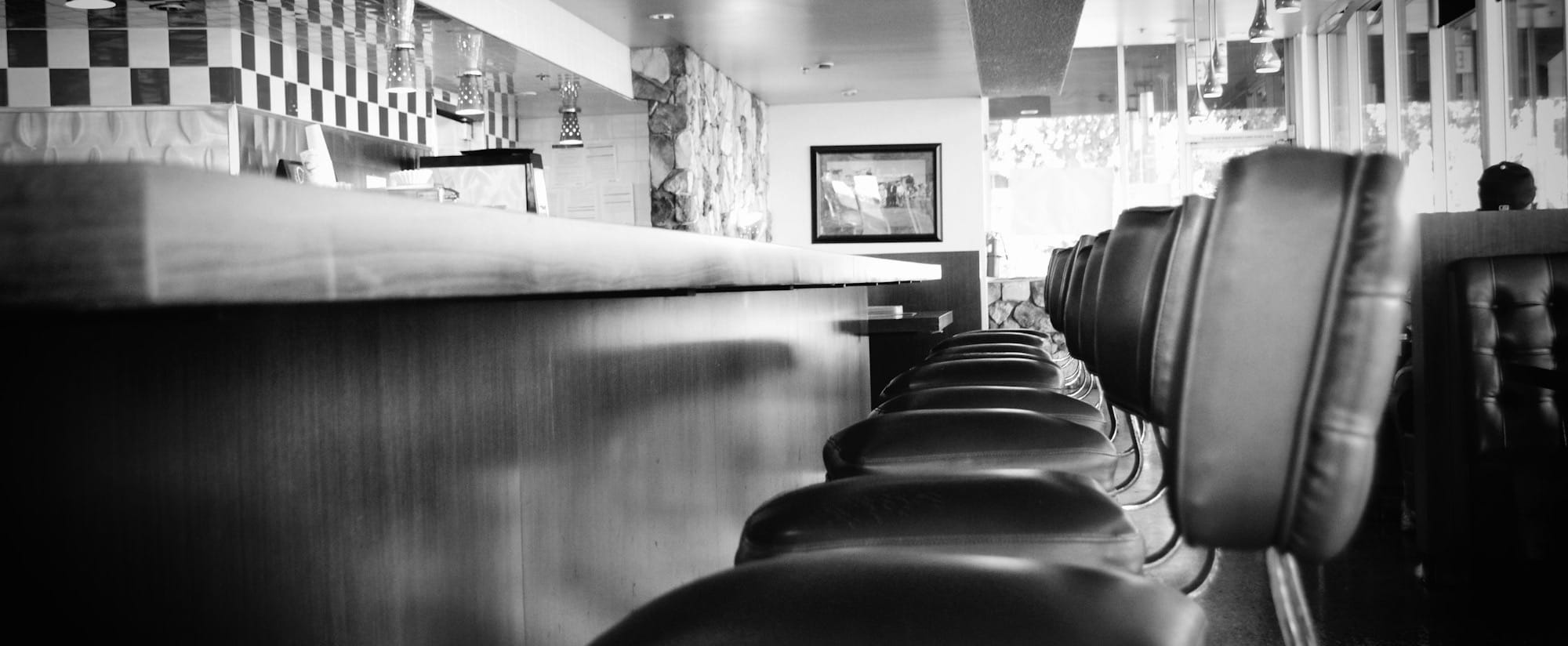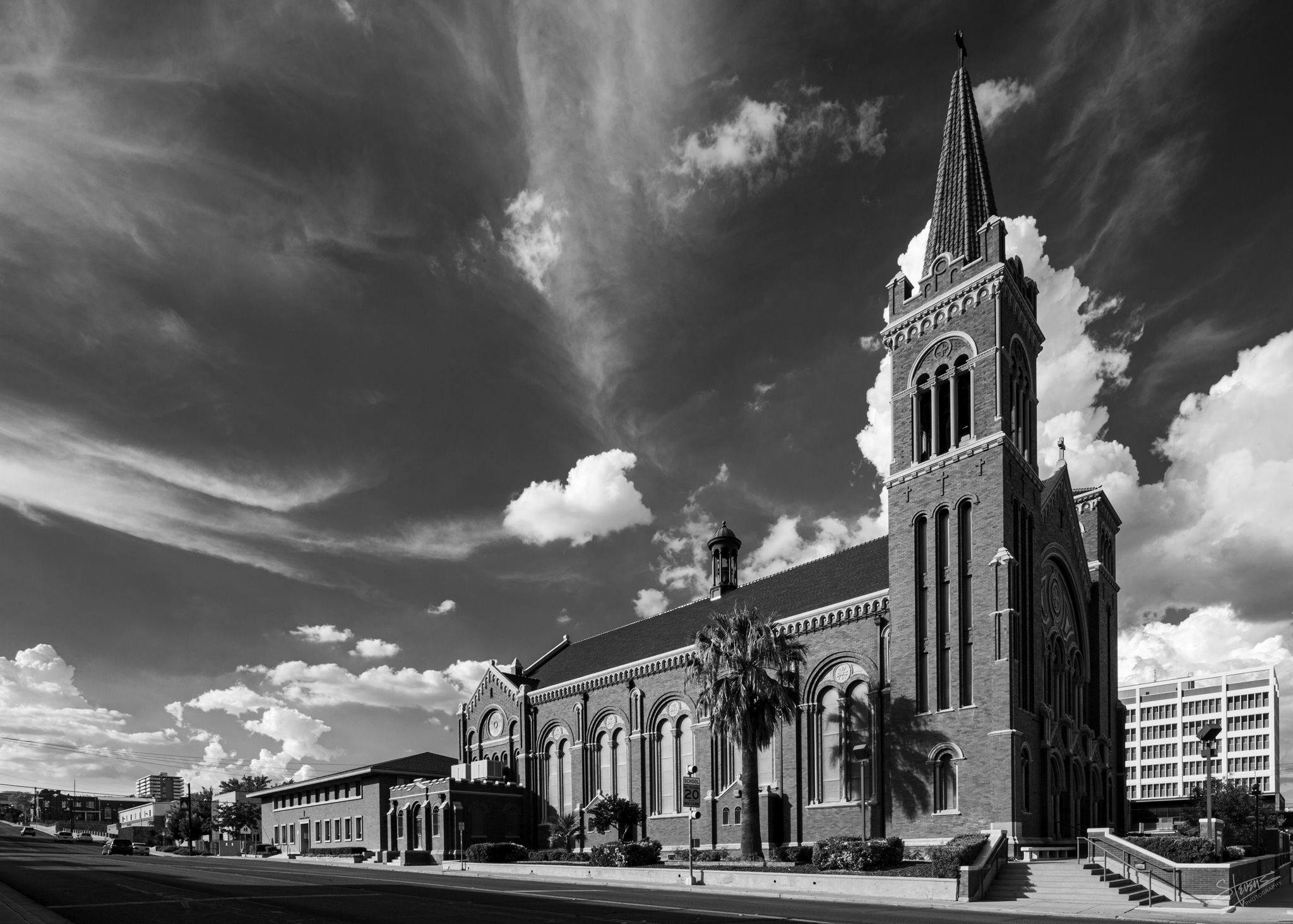The Church on Mesa
Where Shadows Stand and Listen

Earlier that day in El Paso, I’d passed by St. Patrick Cathedral and made myself a quiet promise: I’d return when the sun had dropped a little lower and the shadows knew how to stretch. I wasn’t sure what the shot would be yet, but I knew the light wasn’t ready — and neither was I.
I hadn’t just returned for the light — I’d returned for the stillness, the upward pull, the chance to witness something solid standing against the slipping day.
So I wandered. Found a diner on Mesa and ordered breakfast — at 6:00 PM. A little ritual of mine on the road. No rush. Just coffee, a plate of something hot, and a watchful eye on the horizon. I was only there to kill a little time. Truth be told, I had a date with a church.
At 6:42 PM, right on schedule, I walked the half block, turned the corner, and there it stood — waiting.
The spire of Saint Patrick didn’t call attention to itself. It didn’t have to. It simply rose above everything else around it, casting long shadows that whispered of permanence. That bell tower wasn’t just tall — it was rooted. Confident. Reaching upward with the kind of clarity you rarely find in concrete or faith.
The late sun struck the western face just right, carving every arch and cornice into high relief. Thin cirrus clouds unraveled behind it like cathedral smoke. The palm in the foreground leaned into frame like a knowing accomplice. Everything had taken its place without being asked.
I had passed this church dozens of times on previous trips, usually at high noon when the West Texas sun flattens everything it touches. At midday the brickwork went mute — an unbroken sheet of dull terra-cotta, windows dark as shuttered eyes. But in the long slant of evening, when the sky cooled from cobalt to deep lapis and the sun drifted toward the Rio Grande, the façade relaxed. Rows of red brick suddenly revealed subtle striations; carved stone accents caught a soft amber glow. Even the mortar seemed to breathe, each joint casting a feather-thin shadow that traced the architecture’s hidden pulse.
I lingered at the curb for several minutes before I lifted the camera. You can rush a snapshot, but you can’t rush an encounter. A church, even an empty one, has its own pulse. You have to listen for it. I could just make out the echo of traffic two blocks over, the hush of a yard sprinkler sputtering to life, the muffled thunk of a basketball meeting asphalt somewhere behind the rectory wall. Inside the sanctuary, I imagined a residual hush — voices lowered out of habit, footsteps softened by varnished pine. A silence shaped by decades of hymns.
I framed the shot wide, then tighter, then wider again. The lens kept finding new geometry: a lozenge window balanced against the palm fronds, the steeple’s taper mirroring the sliver of moon that had begun to appear in the south. Light pooled on the transept like a chalice suddenly filled. At one point a bird — a grackle, probably — landed on the crossbeam, held its posture for the length of a single shutter click, then vanished. A black note added and erased in the same breath.
I slowed down. Framed deliberately. Waited. And when I released the shutter, I knew I’d kept my end of the promise. I hadn’t just returned for the light — I’d returned for the stillness, the upward pull, the chance to witness something solid standing against the slipping day.
I thought of how faith and photography share an uneasy covenant with time. Both try to hold something fleeting — an instant, a breath, a promise — knowing full well that the holding will never be complete. You press the shutter, freeze one thirty-second of a second, and call it truth. A worshiper kneels, whispers a confession, and calls it surrender. Neither gesture is permanent, yet both alter the one who makes it.
Saint Patrick began as a mission church in 1907, back when this neighborhood was little more than adobe houses and mesquite scrub. The first parishioners hauled pews in borrowed wagons; nuns stitched altar linens by kerosene lamplight. Now the newer building finds itself hemmed by condos and coffee shops, its bell tower in dialogue with cell-phone masts. You could argue the church no longer anchors the community the way it once did. But some anchors drift from view only to deepen their hold below the waterline.
Three children on bicycles glided past, pausing at the corner to squint up at the steeple. One pointed, said something I couldn’t hear, and they pedaled on. For a flicker of a moment their silhouettes flared gold, then fell back into evening shadow — time reminding me to press the shutter again.
The sun finally slid behind the post office, and the façade lost its luminous edge. The spire didn’t shrink, but its stern silhouette softened, as if exhaling after a long day of vigilance. I gathered my gear and stepped backward once, preserving the last frame in my mind.
Long after I left the block — camera bag still radiating the day’s stored heat, a faint dusty dryness lingering on my sleeves — I felt the tower’s quiet insistence following me. Not an admonition, not even a benediction. Just a presence: brick and stone alive with memory, angles holding vigil. A reminder that some architecture is less about shelter than about orientation — a compass point carved into sky, telling anyone who cares to look that heaven, like true north, never moves even when the world tilts.
And what is a photograph if not a similar attempt? A slender spire of attention rising against the churn of hours, steady for an instant, quietly pointing beyond itself.
It wasn’t just a beautiful church. That evening, it was a companion. A structure built to catch the last light and hold it like a prayer.
Where do you find quiet when you need to hear yourself think?
— Lawrence

Thanks for reading Still Stories! Subscribe for free to receive new posts and support my work.

